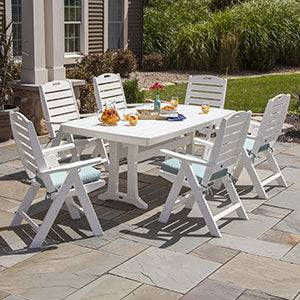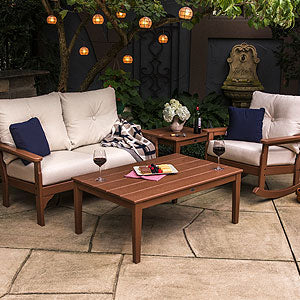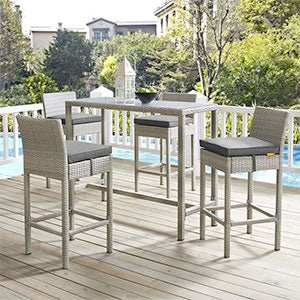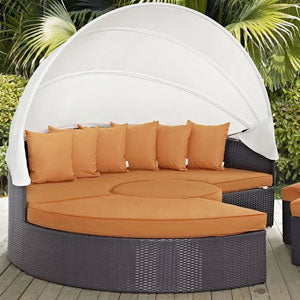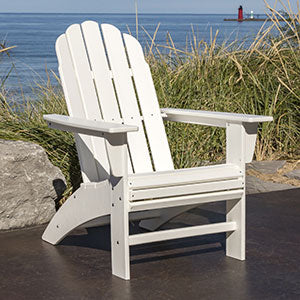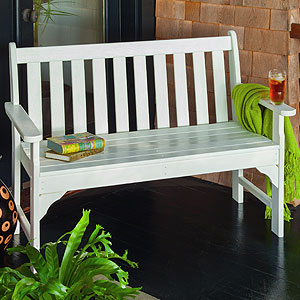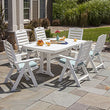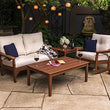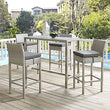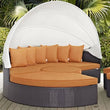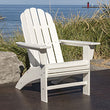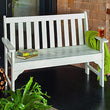Patio Furniture Materials Comparison Guide
How to Choose the Best Material for Outdoor Furniture
When selecting outdoor patio furniture, you’re going to consider many of the same factors you would when buying indoor furniture: durability, style, comfort, and price. The main difference with purchasing outdoor furniture, however, is that is has to withstand exposure to the elements and a variety of weather conditions. While no material is completely weatherproof, each type of material used in patio furniture construction has its strengths and weaknesses. Before buying furniture for your deck, porch, or patio, determine how each material aligns with the needs of your personal preferences and environment. Here’s some information on common materials to help you choose the best one for your needs.
Factors to consider and use to compare materials
Outdoor furniture has to retain its structural integrity and appearance throughout the seasons, under different weather conditions, and over many years of use. When comparing the pros and cons of each material, here’s some factors to consider.

- Rain and moisture – In wet and humid locations, your furniture needs to be resistant to water-based issues that can cause material degradation
- Mold and mildew – Moist conditions can create an environment where mold and mildew-causing fungi thrive which can lead to respiratory problems if not cleaned off surfaces.
- Rust and corrosion – Some metals that contain iron or steel can rust and corrode when continually exposed to water and oxygen. In coastal regions, salt in the air and water speeds this process.
- Warping and cracking – If the material allows water penetration to dry unevenly, warping, bending, bowing, and cracking can distort the original shape and create misaligned seams and loosened joints or fasteners.
- Sun and temperature – Harsh UV rays, direct sunlight, and temperature extremes from hot to cold can damage materials over time.
- Fading – Continued exposure to sunlight can fade many materials and finishes over time leading to loss of luster and color vibrancy over time.
- Retention – Some materials, particularly metals, can retain heat when left out in the sun, making the furniture uncomfortable to sit on and unsafe to touch.
- Wind resistant – It’s important to have furniture that is heavy enough to not tip over or blow away in extremely windy conditions.
- Durability – The more frequently the furniture is used, the more durable the materials its made of should be, so it will last longer.
-
Cleaning and care – All furniture requires some cleaning and maintenance. Some materials are easier to take care, while others require more time and effort to keep them looking great.
- Eco-friendliness – Production processes and raw materials can have an environmental impact and vary in their renewability. Look for brands that have adopted “green” manufacturing processes and use materials that are biodegradable, recyclable, or certified as eco-friendly.
- Cost – Everyone has a budget when it comes to buying patio furniture. Weigh the price versus the benefits value to determine the financial implications of choosing one material over another and how expensive the furniture will be in the long run.
Comparison of Common Patio Furniture Materials
Metal Patio Furniture
Metal is one of the strongest and most durable materials for outdoor patio furniture. Metal frames can be shaped into complex design and be made thinner due to the strength of the material, allowing for great style and design flexibility. Its heavyweight and sturdy construction will ensure the furniture stays put under windy conditions, but makes it harder to move. Metal does have its drawbacks, however. It can heat up in the sun, so its uncomfortable to touch. Metals are also prone to rust and corrosion and require more upkeep on the finishes, so they may not be the best choice for wet or coastal regions.

- Aluminum – Lightweight and strong, aluminum is relatively inexpensive, low-maintenance, and does not rust. A powder-coat finish is recommended to provide extra protection against the elements.
- Wrought or Cast Iron – Heavy and durable, wrought iron can be expensive, but can be made into intricate and ornate designs. Wrought iron furniture should be powder-coated to prevent rust. If the paint becomes scratched, sand the area and apply touch-up paint to keep rust at bay.
- Steel – Like iron, steel is strong but vulnerable to rust and corrosion when exposed to water and oxygen which weakens and discolors the metal. Salty air can accelerate this chemical process. Regular steel should be painted to help prevent rust, or you can select stainless steel which will hold up better in weather, but is more expensive.
Wood Patio Furniture
Wood has always been a popular material for outdoor furniture manufacture. It is easy to work with, provides a sturdy framework for chairs, tables, benches, and sofas, and has a natural beauty that you can’t get with other materials. When it comes to outdoor usage, not all woods are created equal in regards to durability and weather resistance. Some stand up to moisture and insect damage better than others while others are much heartier and withstand the elements. Many soft woods such as pine, cedar, and fir are inexpensive and widely used in such items as picnic tables and chairs, but require constant protection to stand up to the weather. Hardwoods are denser and harder to work with and more expensive than softwoods, but tend to resist weather damage and last much longer with proper care.

- Teak – Teak is a fine-grained hardwood that is ideally suited for outdoor use. Though expensive, it is strong and is not prone to warping or cracking. Its natural oils repel moisture and keeps the wood from expanding or contracting in the drying process. It is resistant to rot, decay, and insects and will last decades. Its natural honey color can be maintained with periodic oiling; otherwise, it will patina to a silver-gray color over time if left untreated.
- Eucalyptus – This strong, fast-growing Australian hardwood lasts long like teak, but costs less. It is also weather and rot resistant due to its natural oils which also act as an insecticide. A sealant is recommended to minimize uneven moisture retentions and maintain its natural, rustic appearance. Unless oiled, it will also develop a silver patina in time.
- Acacia – Reddish-brown in color, acacia wood is readily available and fairly inexpensive, but is more prone to warping or cracking than eucalyptus.
- Ipe – Also known as ironwood, this hardwood comes from Central and South American and features a deep, richly colored grain that fades slower than other wood when exposed to weathering. It has a high natural oil content to help resist insects and slow decay. Its hard and dense structure make it strong, but difficult to work with.
- White Oak – Long used for boat building, white oak is hard, strong, and abundant. It structure gives it the ability to repel water which helps make it rot resistant. Because it does not contain much natural oils, it requires a paint finish or sealant to retain its durability. Untreated white oak will develop a gray patina when exposed to the elements.
- Rattan – Though the term rattan is often used interchangeably with wicker, they are not the same. Eco-friendly and sustainable, rattan is a fast-growing, fibrous climbing vine that is used as a material to make furniture. Wicker refers to the woven pattern that is created from the rattan. Rattan is versatile and hardy with designs that look great in coastal, boho, and even traditional decors. It handles the harsh sun and cold too, but should be protected against moisture as it can soak up water. A coating of lacquer will make it more rain-resistant if used in an uncovered outdoor space. To make it more comfortable, rattan furniture should be used with cushions or padding on the seat.
Plastic Patio Furniture
Manmade synthetic materials including plastic and resin have become more prevalent in the manufacture of outdoor furniture. Modern manufacturing processes enable these polymers to form a wide range of shapes, sizes, and colors. Plastic patio furniture is lightweight, less expensive than other materials, and can be molded into designs to suit any décor style. The colors are inherent in the chemical makeup of the material so they are fade resistant and don’t require sealants or painted finishes. Plastic furniture is easy to maintain too, and only require cleaning with soap and water as needed.

- HDPE/Polywood Lumber – High-density polyethylene (HDPE) is a high-quality plastic, often made of recycled materials, that can be exposed to UV rays for decades without experiencing any degradation. It is highly puncture resistant, strong, dense, and easy to clean. It resists fading, is lightweight, and can be molded into a wide range of shapes and designs.
- PVC – Polyvinyl chloride (PVC) is another popular plastic used in patio furniture. While durable and easy care, it is not as resistant to UV exposure and can crack or become brittle over time.
- Polypropylene – Polyethylene (PE) is cost-effective and commonly used in patio furniture, but is not as weather-resistant and durable as HDPE. It is lighter in weight and resistant to chemical degradation and heat damage.
- Resin – Synthetic polyethylene resin is the material choice for all-weather wicker furniture that provides the woven texture and appearance of natural rattan wicker patio furniture without the upkeep. While it looks like natural wicker, resin or synthetic wicker furniture is stronger, more durable, and resistant to moisture, water, and humidity. It also comes in a variety of colors without the use of a painted finish that would be required for rattan.
Furniture Made of Combined Materials

Outdoor furniture can utilize a number of materials along with wood, metal, or plastic. Some types may also combine materials such as a dining table with a glass top and metal or wicker frame. Others may use a blend of materials such as wood and metal. When choosing furniture made of a combination of materials, consider the environment they will be used in and take into account the durability and maintenance needed for each component, along with what materials best suit your specific functional and aesthetic needs.
Patio Furniture Cushions, Pillows, Umbrellas, and Furniture Fabrics
Fabrics used for outdoor patio furniture includes those used for seat and back cushions, throw pillows, umbrellas, and integrated as part of the actual piece such as sling-style chairs, hammocks, and loungers. Any fabric used outdoors needs to withstand constant exposure to harsh sun, rain, humidity, and temperature extremes. Since natural fibers tend to fade and break down over time, fabrics made from synthetic threads which are infused with plastic are a better choice for outdoor upholstery, cushions, and pillows.

- Sunbrella – The gold standard of acrylic outdoor fabrics, Sunbrella is a premium-grade material that ranges for softer textiles used for home patio furniture to marine-grade fabric that holds up under saltwater, wind, and sun on boats and yachts. Easy to clean, mold and stain-resistant, Sunbrella can also be used for indoor furniture upholstery in high traffic areas. Its easy-care and durability are worth the higher price tag.
- Olefin – Olefin is a solution-dyed synthetic fabric that’s durable, quick-drying, and fade-resistant. Lightweight and smooth in texture, it does lack some of the softness of other fabrics. It withstands moisture, mold, and heat, and is easy to clean.
- Textilene – Textile mesh is a premium synthetic fabric used in many luxury outdoor furniture brands, especially in the seats and sling-backs of lounge chairs and sofas. Its open weave allows airflow to keep the material cool and let it dry quickly. It is ideal for furniture used by the poolside.
- Polyester – Polyester is a synthetic material that is coated with acrylic or vinyl, making it strong, flexible, and water resistant. It dries quickly and resistant tears. But because polyester threads are dipped in color or have the color painted on, they will fade faster than solution-dyed fabrics.


